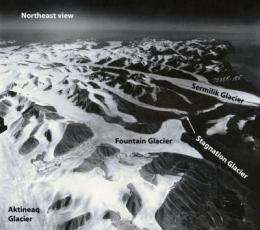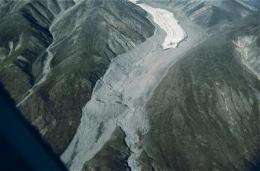Shrinking Bylot Island glaciers tell story of climate change

The U.S. Geological Survey has released the results of a long-term study of key glaciers in western North America, reporting this month that glacial shrinkage is rapid and accelerating and a result of climate change.
University of Illinois geologist William Shilts spent nearly two decades studying glaciers on Bylot Island, an uninhabited island about 300 miles southwest of Thule, Greenland. He, his students and other geologists who followed in his footsteps have chronicled the decline of several Bylot Island glaciers. Photos of the island from the 1940s to the present offer a vivid picture of the changing glaciers and the forces that shape their retreat.
For a slide show of the glaciers from 1948 to the present, please go to: http://news.illinois.edu/slideshows/bylot_glacier/index.html.
"I started working in the late 1970s on Bylot Island, which is about the size of New Jersey," said Shilts, the executive director of the Institute of Natural Resource Sustainability at Illinois. "Bylot Island is like a miniature North America. It has a very old crystalline rock core that's covered with ice and glaciers, and it's surrounded by younger rocks."
"As time went on it became very evident that the glaciers on Bylot Island were, for the most part, retreating, shrinking, melting faster than ice could be produced," he said. "For whatever reason, the summer melting was exceeding the winter snowfall."
With a perspective spanning more than 4 billion years, geologists have a unique point of view on current climate changes. They know that ice ages and glacial retreats are common because these events leave indelible marks on the land.
To a geologist's eye, the color of rock near a melting glacier, the pattern of scars on its surface or fissures at its edges, the shape of a mound of gravel left behind or the pattern of snow and ice on its surface speak volumes about the glacier's origin, recent history and age.
Glaciers are perpetually moving, flowing frozen rivers, and like other rivers, they churn up dirt and rocks carry them "downstream." When a glacier retreats, the mud and rocks are often dumped at its edge, forming moraines. The moraines sometimes grow so large that they inhibit the advance of the glacier and cause the ice to thicken, like water filling a bathtub.
The surface of the rocks also tells a story. When a glacier melts, the newly exposed material becomes an inviting habitat for lichen and other organisms, which gradually darken the stone. Such growth can take 50 or 60 years to start, however, so bare rock inside the moraine signals that a glacier has retreated only within the last few decades. Shilts calls the light-colored moraine below the dark lichen-covered rock the glacier's "bathtub ring."
"1948 was the year that the first aerial photographs were taken of Bylot Island and most of northern Canada," Shilts said. "On those photographs you can see that the glaciers were considerably advanced over what they are now. And any boulders that were involved with glacier activities in the 1940s look as fresh as if they were broken off their outcrops yesterday.

They have no lichen or any sort of growth on them. As soon as you go beyond the 1948 boundary, the boulders are covered with black lichen. You can't even see the rock. And so it's a very clear demarcation on the ground."
Shilts photographed many of the same glaciers in the 1980s and 1990s, and other geologists have chronicled the changes up to the present. These photos show a steady and rapid decline in the extent of several glaciers: Stagnation Glacier, covered in a layer of rock and debris, has shrunk considerably since 1948.
Nearby Fountain Glacier seems more stable, but the outwash plain below it, a zone always coated in a thick layer of ice, even throughout the summer, was completely dry in the summer of 2008.
Aktineq Glacier has shrunk back about a kilometer since 1948, Shilts said. Most of the other glaciers on Bylot Island, and on nearby Baffin Island, also appear to be melting away.
A glacier that shrinks over a period of decades may seem like an overt sign of a warming climate, but other contributors to glacial retreat are less obviously tied to climate change. Warmer temperatures can bring on more frequent freeze-thaw cycles that open fissures in the rock walls above a glacier, dumping debris on the glacier's surface that hastens melting by absorbing more of the sun's heat.
A more precise way of timing glacial events involves radiocarbon dating the soil in embankments near glacial moraines. Shilts and his colleagues conducted such studies on Bylot Island, and found that an undisturbed sand bank near a glacial moraine was about 6,800 years old.
"That means at the very least that the glacier that is a couple of feet away from that sand bank has not gone across that sand bank in 6,800 years," he said.
Another approach, called cosmogenic dating, indicated that the boulders just outside the 1948 moraine were even older. The technique, conducted by Shilts' former graduate student, Shirley McCuaig, dated those boulders at 55,000 years, plus or minus 5,000 years.
That finding confirmed something that another student, Rod Klassen, had suggested in his PhD thesis at Illinois, Shilts said. "And that is that the glaciers that are now on Bylot Island were as far advanced in the 1940s as they have been in the last 55,000 years. And now they are retreating."
"My interpretation of what I saw on Bylot Island is that we're in another cycle of glacial retreat," Shilts said. "Whether that cycle is primarily driven by human emissions of carbon dioxide in the atmosphere creating a warming trend, or whether it's driven by natural cycles, which relate to our orbit around the sun, sunspot activity or various things in the earth's atmosphere in general, I can't say."
"My personal opinion is that this is a combination of both factors," Shilts said. "There's a normal cycle here - we're coming out of the 'Little Ice Age,' and have been for some time. At the same time, the Industrial Revolution has begun to load the atmosphere with carbon dioxide among other things. There's a human effect, and there's a natural effect, and sorting out those two is very difficult."
Source: University of Illinois at Urbana-Champaign (news : web)















